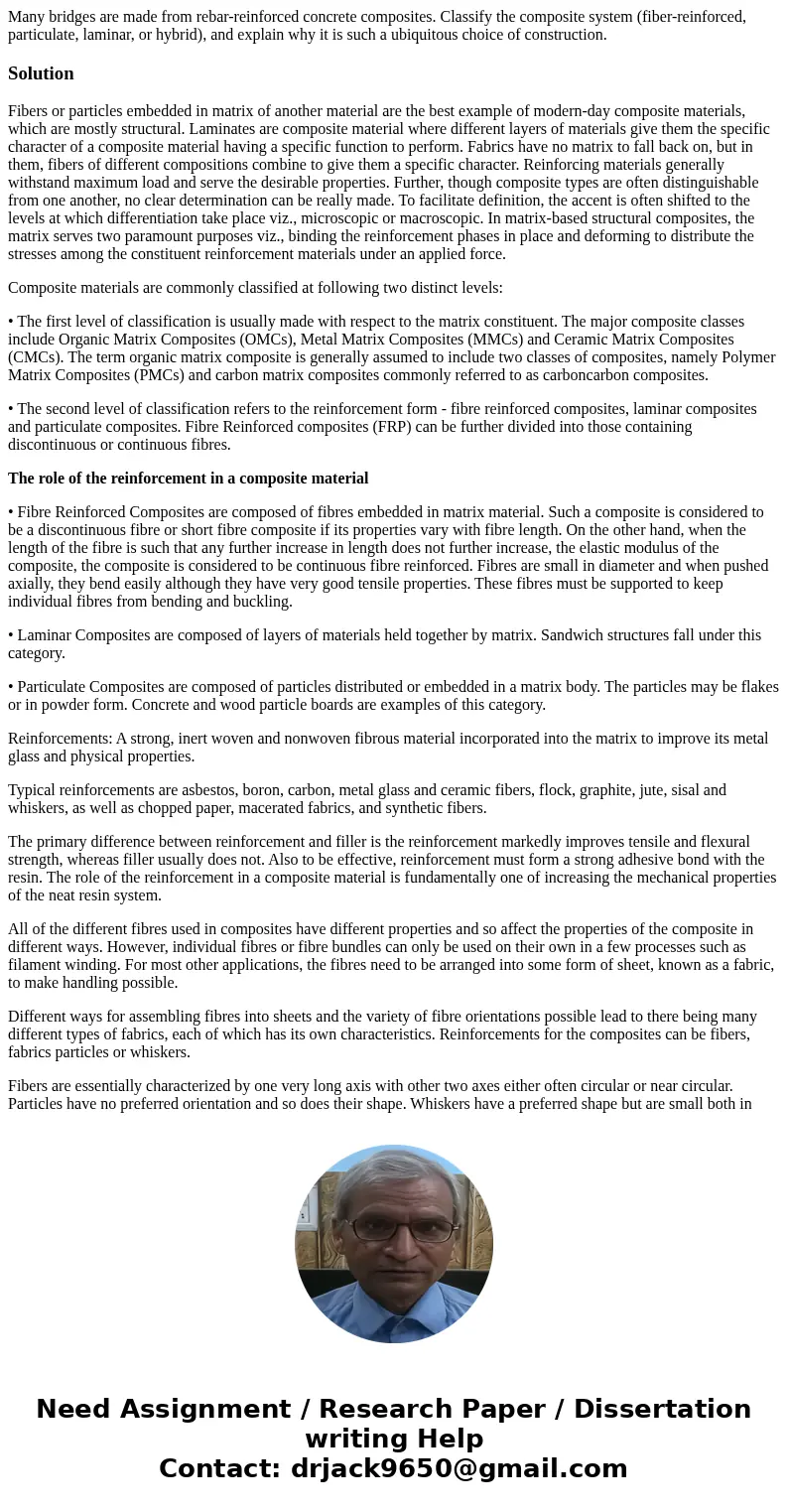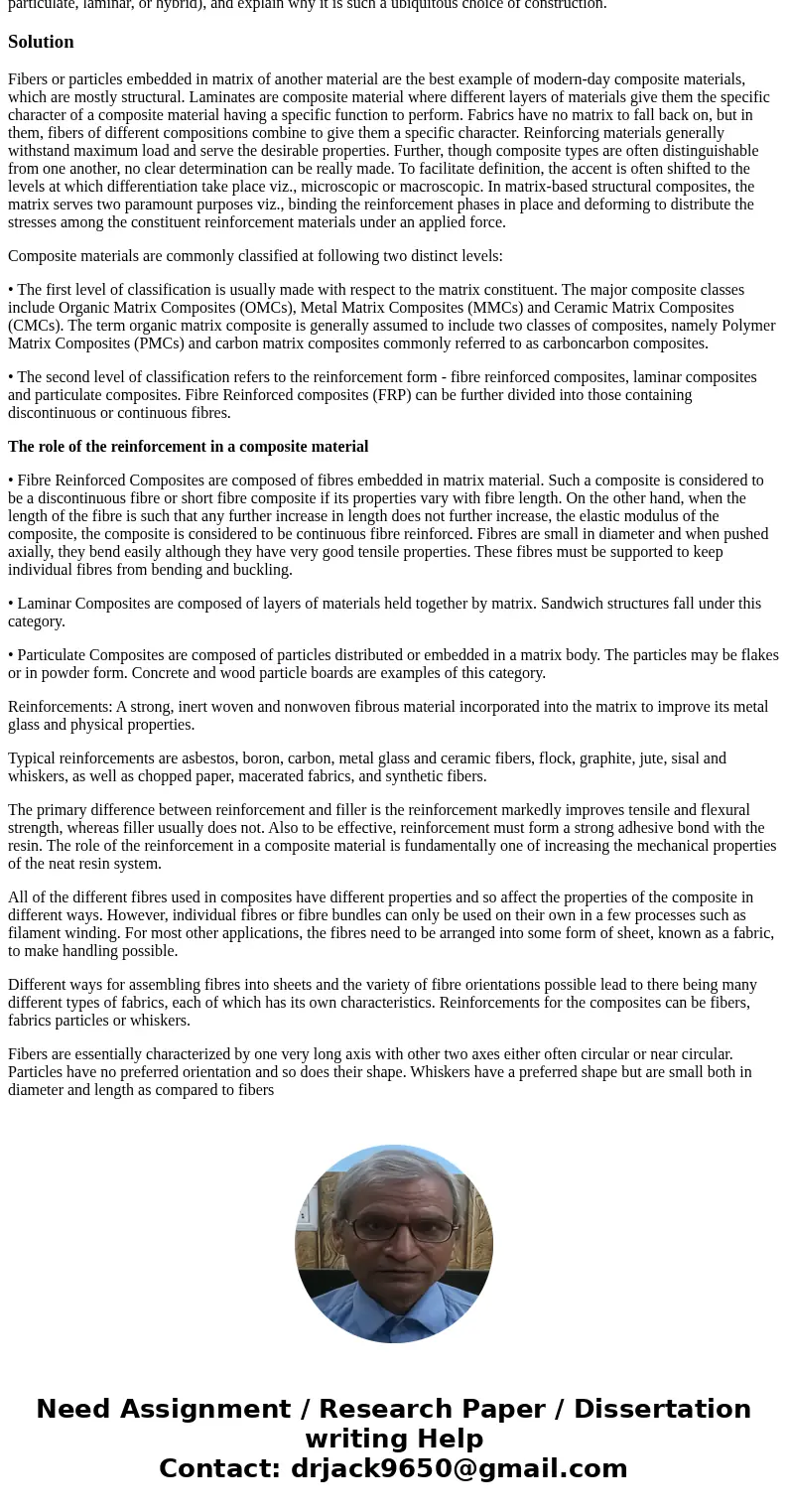Many bridges are made from rebarreinforced concrete composit
Many bridges are made from rebar-reinforced concrete composites. Classify the composite system (fiber-reinforced, particulate, laminar, or hybrid), and explain why it is such a ubiquitous choice of construction.
Solution
Fibers or particles embedded in matrix of another material are the best example of modern-day composite materials, which are mostly structural. Laminates are composite material where different layers of materials give them the specific character of a composite material having a specific function to perform. Fabrics have no matrix to fall back on, but in them, fibers of different compositions combine to give them a specific character. Reinforcing materials generally withstand maximum load and serve the desirable properties. Further, though composite types are often distinguishable from one another, no clear determination can be really made. To facilitate definition, the accent is often shifted to the levels at which differentiation take place viz., microscopic or macroscopic. In matrix-based structural composites, the matrix serves two paramount purposes viz., binding the reinforcement phases in place and deforming to distribute the stresses among the constituent reinforcement materials under an applied force.
Composite materials are commonly classified at following two distinct levels:
• The first level of classification is usually made with respect to the matrix constituent. The major composite classes include Organic Matrix Composites (OMCs), Metal Matrix Composites (MMCs) and Ceramic Matrix Composites (CMCs). The term organic matrix composite is generally assumed to include two classes of composites, namely Polymer Matrix Composites (PMCs) and carbon matrix composites commonly referred to as carboncarbon composites.
• The second level of classification refers to the reinforcement form - fibre reinforced composites, laminar composites and particulate composites. Fibre Reinforced composites (FRP) can be further divided into those containing discontinuous or continuous fibres.
The role of the reinforcement in a composite material
• Fibre Reinforced Composites are composed of fibres embedded in matrix material. Such a composite is considered to be a discontinuous fibre or short fibre composite if its properties vary with fibre length. On the other hand, when the length of the fibre is such that any further increase in length does not further increase, the elastic modulus of the composite, the composite is considered to be continuous fibre reinforced. Fibres are small in diameter and when pushed axially, they bend easily although they have very good tensile properties. These fibres must be supported to keep individual fibres from bending and buckling.
• Laminar Composites are composed of layers of materials held together by matrix. Sandwich structures fall under this category.
• Particulate Composites are composed of particles distributed or embedded in a matrix body. The particles may be flakes or in powder form. Concrete and wood particle boards are examples of this category.
Reinforcements: A strong, inert woven and nonwoven fibrous material incorporated into the matrix to improve its metal glass and physical properties.
Typical reinforcements are asbestos, boron, carbon, metal glass and ceramic fibers, flock, graphite, jute, sisal and whiskers, as well as chopped paper, macerated fabrics, and synthetic fibers.
The primary difference between reinforcement and filler is the reinforcement markedly improves tensile and flexural strength, whereas filler usually does not. Also to be effective, reinforcement must form a strong adhesive bond with the resin. The role of the reinforcement in a composite material is fundamentally one of increasing the mechanical properties of the neat resin system.
All of the different fibres used in composites have different properties and so affect the properties of the composite in different ways. However, individual fibres or fibre bundles can only be used on their own in a few processes such as filament winding. For most other applications, the fibres need to be arranged into some form of sheet, known as a fabric, to make handling possible.
Different ways for assembling fibres into sheets and the variety of fibre orientations possible lead to there being many different types of fabrics, each of which has its own characteristics. Reinforcements for the composites can be fibers, fabrics particles or whiskers.
Fibers are essentially characterized by one very long axis with other two axes either often circular or near circular. Particles have no preferred orientation and so does their shape. Whiskers have a preferred shape but are small both in diameter and length as compared to fibers


 Homework Sourse
Homework Sourse